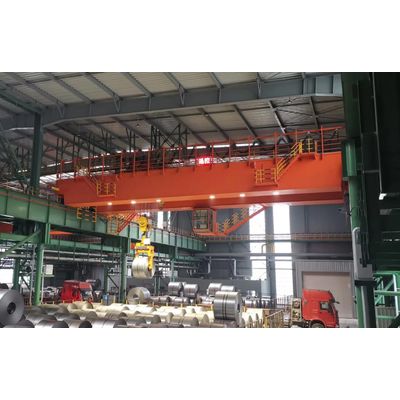

- Home
- Companies
- Aimix Group Co., Ltd
- Articles
- Fatigue Monitoring and Predictive ...

Fatigue Monitoring and Predictive Maintenance in 40 Ton Overhead Cranes
In heavy-duty industrial applications, 40-ton overhead cranes play a vital role in lifting and transporting large and heavy materials. Whether they are used in steel mills, shipyards, power plants, or manufacturing workshops, these cranes are constantly exposed to demanding working conditions that can lead to fatigue and wear over time. Ensuring the structural and mechanical integrity of these cranes is paramount for operational safety, equipment longevity, and cost-efficiency.
This article explores the importance of fatigue monitoring and the implementation of predictive maintenance strategies in 40 ton overhead cranes, highlighting how modern technologies are transforming crane health management from reactive to proactive.
Understanding Crane Fatigue and Failure Risks
What Is Crane Fatigue?
Fatigue in overhead cranes refers to the progressive structural damage that occurs when a material is subjected to repeated cyclic loading. Even when these stresses are below the material’s yield strength, the continuous strain can lead to microscopic cracks that propagate over time, potentially resulting in sudden and catastrophic failure if left unmonitored.
Factors Contributing to Fatigue in 40 Ton Overhead Cranes
Several factors influence fatigue life in overhead cranes, including:
- Load Frequency and Weight: Frequent lifting of heavy loads close to the crane’s rated capacity accelerates fatigue.
- Load Spectrum Variability: Irregular load patterns and dynamic effects (e.g., sudden starts and stops) cause stress concentration.
- Operating Environment: Exposure to high temperatures, corrosion, moisture, or dust impacts material degradation.
- Crane Design and Duty Class: Cranes not designed for high cycles but used intensively are more prone to fatigue-related issues.
The Role of Fatigue Monitoring in Overhead Cranes
Fatigue monitoring is the continuous tracking and analysis of the stress and strain experienced by the crane’s critical components, especially the bridge girders, end trucks, hoisting mechanisms, and trolley frames.
Key Benefits of Fatigue Monitoring
- Early Detection of Structural Degradation: Monitoring helps detect crack initiation and progression before they result in failure.
- Optimized Maintenance Scheduling: Maintenance can be planned based on actual usage and wear, rather than fixed time intervals.
- Safety Enhancement: Continuous monitoring prevents accidents caused by undetected structural fatigue.
- Extended Equipment Life: Proactive intervention helps preserve the crane’s health and delays costly replacements.
Common Fatigue Monitoring Technologies
- Strain Gauges: Installed at high-stress zones to measure deformation under load and identify cyclic stress ranges.
- Load Cycle Counters: Record the number and weight of load cycles to estimate accumulated fatigue damage.
- Acoustic Emission Sensors: Detect high-frequency sounds generated by crack propagation.
- Vibration Sensors: Identify abnormal movements and misalignments that indicate fatigue in bearings or connections.
- Ultrasonic Testing (UT): Periodic NDT (non-destructive testing) method to locate internal cracks.
Predictive Maintenance in 40 Ton Overhead Cranes
Predictive maintenance (PdM) uses data from various sensors and condition monitoring tools to predict when a component is likely to fail, allowing intervention before a breakdown occurs.
How Predictive Maintenance Works
- Data Collection: Sensors collect real-time data on stress, load, temperature, vibration, and usage cycles.
- Data Analysis: Software algorithms and digital twins analyze trends and compare against baseline values.
- Failure Prediction: The system identifies abnormal patterns and predicts remaining useful life (RUL) of components.
- Maintenance Planning: Maintenance tasks are scheduled based on the predicted health status of crane systems.
Components Monitored in Predictive Maintenance
- Hoist and Trolley Motors: Vibration and temperature sensors help detect motor misalignment or bearing wear.
- Wire Ropes and Chains: Monitored for elongation, wear, and tension anomalies.
- Brakes and Clutches: Friction material wear is tracked to prevent braking failure.
Electrical Systems: Insulation resistance and thermal buildup are analyzed to prevent electrical faults.
Integrating IoT and Digital Solutions
Modern 40-ton overhead cranes increasingly incorporate Industrial Internet of Things (IIoT) devices and smart control systems to support fatigue monitoring and predictive maintenance.
Features of Smart Crane Health Monitoring Systems
- Real-Time Data Visualization: Dashboards display crane status, alerts, and performance KPIs.
- Cloud-Based Monitoring: Remote access to overhead crane data for fleet-wide analysis and multi-site comparison.
- Machine Learning Algorithms: Advanced analytics learn from historical data to improve fault detection accuracy.
- Automated Alerts and Reports: Operators and maintenance teams receive notifications when components exceed predefined thresholds.
Case Example: Predictive Maintenance in a Steel Mill
In a steel manufacturing facility, a 40-ton overhead crane operates continuously across three shifts. The crane is critical for moving molten steel and finished slabs. The facility implemented a fatigue monitoring system combined with predictive maintenance to address repeated component failures that were causing production delays.
Sensors were installed on bridge girders, hoists, and motors. Within six months, the system identified abnormal stress accumulation in one of the hoist drums, prompting early replacement. This intervention prevented an unscheduled shutdown, saving over $80,000 in downtime costs and extending the crane's operational life by 20%.
Challenges in Implementing Fatigue Monitoring and PdM
While the benefits are clear, certain challenges can hinder implementation:
- Initial Investment: The upfront cost of installing sensors and software can be significant.
- Data Complexity: Analyzing large volumes of data requires technical expertise and dedicated resources.
- Retrofitting Legacy Cranes: Older cranes may require modification to accommodate new sensors and systems.
- Training Requirements: Maintenance teams need to be trained to interpret sensor data and respond appropriately.
Best Practices for Effective Fatigue and Predictive Maintenance Management
- Baseline Assessment: Start with a structural health assessment of the crane to identify high-risk areas.
- Critical Component Identification: Focus monitoring on parts most prone to fatigue and failure.
- Standardize Data Collection: Use consistent formats and methods to ensure accurate analysis.
- Integrate with CMMS: Link predictive maintenance data to your Computerized Maintenance Management System (CMMS) for seamless planning.
- Periodic Review: Continuously evaluate system performance and fine-tune algorithms for improved prediction accuracy.
Conclusion
Fatigue monitoring and predictive maintenance are no longer optional practices - they are essential for the safe, efficient, and cost-effective operation of 40-ton overhead cranes. By shifting from reactive to proactive maintenance, businesses can reduce unplanned downtime, extend equipment lifespan, and enhance workplace safety. As sensor technology, IoT integration, and data analytics continue to evolve, crane owners and operators must embrace these innovations to stay competitive and protect their investment in heavy lifting equipment.
